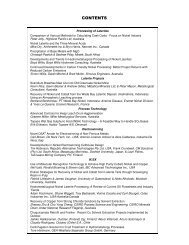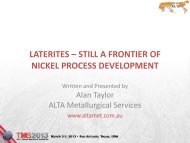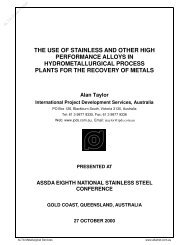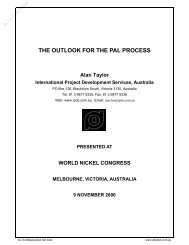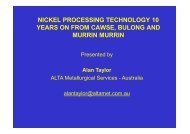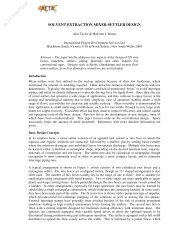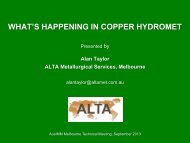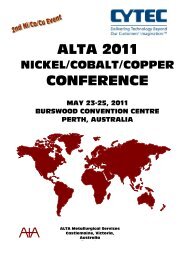review of mixer-settler types and other possible contactors for ...
review of mixer-settler types and other possible contactors for ...
review of mixer-settler types and other possible contactors for ...
You also want an ePaper? Increase the reach of your titles
YUMPU automatically turns print PDFs into web optimized ePapers that Google loves.
ALTA Free Paper<br />
The mix boxes can be operated either with the organic or the aqueous as the continuous phase.<br />
Typically organic continuous is used <strong>for</strong> the final extraction <strong>and</strong> first stripping stages as it generally<br />
results in lower organic entrainment in the raffinate <strong>and</strong> strong electrolyte streams respectively.<br />
Aqueous continuous is commonly, though not exclusively, used <strong>for</strong> the <strong>other</strong> stages. An organic or<br />
recycle stream from the <strong>settler</strong>s back to the mix boxes is commonly incorporated to obtain <strong>and</strong><br />
maintain the operating phase ratio in the mix-boxes required <strong>for</strong> stable operation at the specified<br />
phase continuity.<br />
Mix boxes can be cylindrical or “square”; <strong>settler</strong>s are generally rectangular (though circular <strong>settler</strong>s<br />
have been used). Mix box retention times are typically 2-3 minute <strong>for</strong> extraction units, <strong>and</strong> 2<br />
minutes <strong>for</strong> strip units. Devices such as flow distributors, picket fences <strong>and</strong> various coalescence<br />
aids are installed in the <strong>settler</strong> to improve per<strong>for</strong>mance.<br />
Phase separation rates in the <strong>settler</strong>s are relatively slow, <strong>and</strong> the specific area is typically 3–5 m 3 /h<br />
(<strong>of</strong> combined aqueous <strong>and</strong> organic) per m 2 <strong>of</strong> <strong>settler</strong> area, depending on operating temperature,<br />
aqueous feed composition <strong>and</strong> concentration <strong>of</strong> extractant in the organic phase.<br />
Materials typically used include:<br />
<br />
<br />
<br />
<br />
<br />
Self supporting stainless steel (higher alloys considered <strong>for</strong> chloride levels > 1 g/L).<br />
Concrete lined with stainless steel (higher alloys considered <strong>for</strong> chloride levels > 1 g/L).<br />
Self supporting FRP.<br />
Concrete lined or coated with FRP.<br />
Concrete lined with HDPE.<br />
Covers are generally fitted <strong>for</strong> outdoor units to minimize organic evaporative losses, keep out dust<br />
<strong>and</strong> minimize heat loss.<br />
Extensive ongoing development work has been carried out on numerous aspects <strong>of</strong> the<br />
conventional <strong>mixer</strong>-<strong>settler</strong> to improve per<strong>for</strong>mance, <strong>and</strong> reduce capital <strong>and</strong> operating costs. These<br />
include:<br />
<br />
<br />
<br />
<br />
<br />
<br />
<br />
<br />
<br />
<br />
<br />
<br />
<br />
Mix box feed arrangements.<br />
Mix box anti-vortex baffles.<br />
Multiple mix boxes.<br />
Design <strong>of</strong> pump-<strong>mixer</strong>s <strong>and</strong> auxiliary agitators.<br />
Settler feed systems.<br />
Design, number <strong>and</strong> location <strong>of</strong> picket fences in the <strong>settler</strong>.<br />
In-<strong>settler</strong> baffles to accelerate coalescence <strong>and</strong> reduce entrainment.<br />
In-<strong>settler</strong> packing to accelerate coalescence <strong>and</strong> reduce entrainment.<br />
Settler configuration including depth <strong>and</strong> floor slope.<br />
Settler design velocities.<br />
Design <strong>of</strong> <strong>settler</strong> discharge weirs to minimize turbulence.<br />
Design <strong>of</strong> <strong>settler</strong> weir boxes <strong>and</strong> recycle systems.<br />
Settler crud removal systems.<br />
Figure 1 shows a typical two mix box arrangement set up <strong>for</strong> aqueous phase recycle.<br />
2



